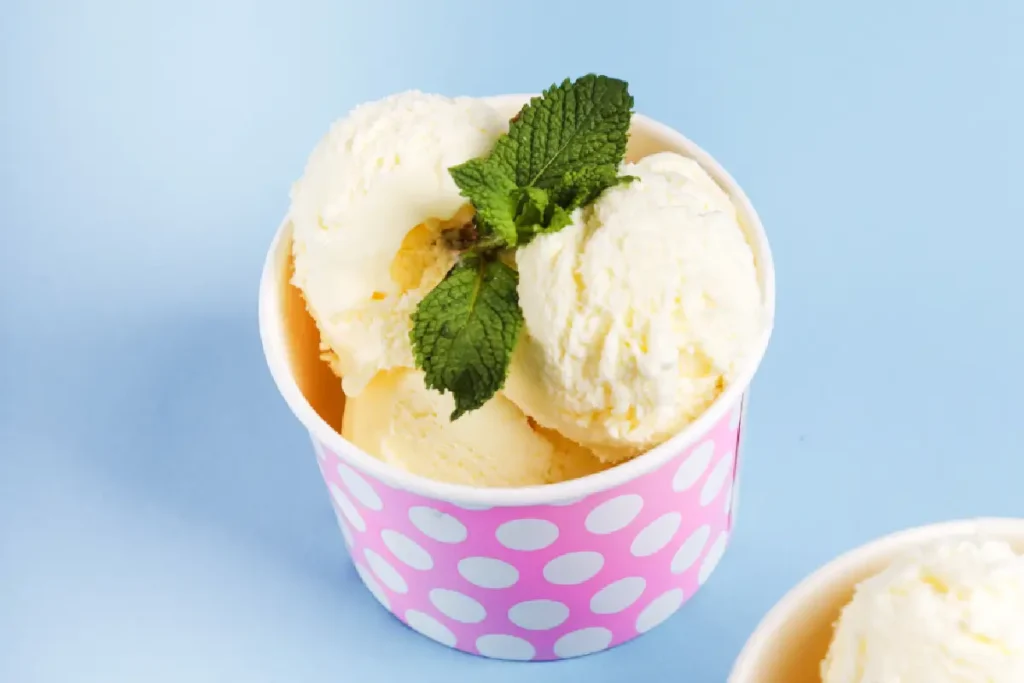Dive into the refreshing world of pineapple sherbet, a delightful treat that promises both flavor and nourishment. This article peels back the layers of this popular dessert, offering a comprehensive guide from its tangy origins to tips for crafting the perfect scoop at home. So, let’s embark on this flavorful journey together, exploring why pineapple sherbet is more than just a dessert—it’s a vibrant celebration of health and happiness.
Introduction to Pineapple Sherbet
Imagine a world where desserts are not only irresistibly delicious but also good for you. Enter pineapple sherbet, a frozen delight that combines the tropical zest of pineapples with the creamy texture of sherbet. Unlike its dairy-heavy counterparts, pineapple sherbet offers a lighter, more refreshing taste, making it an ideal choice for those warm, sunny days or when you’re simply craving something sweet yet healthy.
Pineapple sherbet is more than just a treat; it’s a versatile dessert that caters to a wide array of dietary preferences, including vegan and lactose-intolerant foodies. Its main ingredient, pineapple, is a powerhouse of nutrients, packed with vitamins, antioxidants, and enzymes that promote overall health.
But what sets pineapple sherbet apart is its ability to transport you to a tropical paradise with just one spoonful. Its vibrant flavor and smooth texture make it a standout dessert, perfect for any occasion. Whether you’re hosting a backyard BBQ or enjoying a quiet night in, pineapple sherbet is sure to be a hit.
The History of Sherbet
Sherbet, a word that conjures images of icy treats and exotic flavors, has a rich history that spans continents and centuries. The concept of sherbet originates from the Middle East and South Asia, where it began not as the frozen dessert we know today but as a sweetened drink made with fruit juices and flavored with rosewater or herbs. It was a symbol of hospitality and refreshment, especially in regions plagued by hot climates.
As trade routes expanded, the idea of sherbet traveled across the Mediterranean to Europe, where it evolved into a frozen form thanks to the introduction of snow and ice preservation techniques. By the 17th century, sherbet had become a popular treat among European nobility, who enjoyed it as a sophisticated palate cleanser between courses during lavish feasts.
The transition from sherbet as a drink to a frozen dessert is a testament to human creativity and the blending of cultures. It’s fascinating to think about how the sherbet we enjoy today is connected to ancient traditions of hospitality and refreshment.
Evolution of Pineapple Sherbet
The introduction of pineapple flavor into the world of sherbet marked a significant milestone. Pineapples, with their exotic allure and intense sweetness, were once considered a symbol of luxury and status in Europe. Incorporating pineapple into sherbet brought a taste of the tropics to the dessert course, making it an instant favorite.
In the United States, pineapple sherbet gained popularity in the early 20th century, especially in regions where fresh fruit was readily available. Its refreshing taste and health benefits made it a preferred choice over heavier, cream-based ice creams.
Today, pineapple sherbet stands as a beloved dessert that continues to delight people around the globe. Its history is a reminder of the dessert’s journey from a simple drink to a frozen treat enjoyed by many.
Nutritional Benefits of Pineapple Sherbet
Pineapple sherbet is more than just a tantalizing treat for your taste buds; it’s a nutritional powerhouse that packs a punch of health benefits. Let’s peel back the layers and discover the wholesome goodness hidden within this tropical delight.
A Bounty of Vitamins and Minerals
Pineapples, the star ingredient of pineapple sherbet, are loaded with a variety of vitamins and minerals essential for good health. Here’s a snapshot of what you’re getting in every spoonful:
- Vitamin C: A champion for your immune system, vitamin C also plays a crucial role in skin health by promoting collagen production.
- Manganese: This mineral supports bone health and aids in the metabolism of carbohydrates and proteins.
- Fiber: While sherbet isn’t as high in fiber as fresh pineapple, it still contributes to your daily intake, helping to maintain digestive health.
Antioxidants and Anti-Inflammatory Properties
Pineapples are rich in antioxidants, which fight against oxidative stress and reduce the risk of chronic diseases. They also contain bromelain, an enzyme with potent anti-inflammatory and digestive benefits. Bromelain can help alleviate inflammation, making pineapple sherbet a smart choice for those looking to enjoy a sweet treat that also supports their well-being.
Low-Fat and Dairy-Free Options
For those monitoring their fat intake or following a dairy-free diet, pineapple sherbet offers a refreshing alternative to traditional ice cream. Many recipes for pineapple sherbet minimize or completely omit dairy products, focusing instead on the fruit’s natural creaminess when frozen. This makes it a lighter, healthier option that doesn’t skimp on flavor.
For a deeper dive into the health benefits of fruit-based desserts, check out our article on Strawberry Tres Leches Cake: A Fusion of Flavors You Can’t Resist, which combines delicious taste with nutritional value.
A Hydrating Dessert
Given its high water content, pineapple sherbet is also a hydrating choice for hot summer days. It can help replenish fluids and keep you cool, all while satisfying your sweet tooth.
In summary, pineapple sherbet is not just a dessert; it’s a nutrient-rich option that can fit into a balanced diet. Its combination of vitamins, minerals, and antioxidants, along with its potential for low-fat and dairy-free variations, makes it a standout choice for health-conscious dessert lovers.
Homemade Pineapple Sherbet Recipes
Creating your own pineapple sherbet at home is a breeze, and it’s a fantastic way to enjoy this tropical treat with a personal touch. Here, we’ll walk through a basic recipe and then explore variations to suit every palate.
Basic Pineapple Sherbet Recipe
Ingredients:
- 2 cups fresh pineapple, diced
- 1 cup sugar (adjust to taste)
- 1 cup water
- 1 tablespoon lemon juice
- 1 cup heavy cream or coconut milk (for a dairy-free version)
Instructions:
- Puree the Pineapple: Blend the pineapple in a food processor until smooth.
- Make a Simple Syrup: Combine sugar and water in a saucepan over medium heat. Stir until the sugar dissolves completely, then let cool.
- Mix: Combine the pineapple puree, simple syrup, and lemon juice. Mix well.
- Add Cream: Stir in the heavy cream or coconut milk until the mixture is well combined.
- Freeze: Pour the mixture into an ice cream maker and churn according to the manufacturer’s instructions. If you don’t have an ice cream maker, pour the mixture into a shallow dish and freeze, stirring every 30 minutes to break up ice crystals.
- Enjoy: Once the sherbet reaches the desired consistency, serve immediately or transfer to a freezer-safe container for later.
Variations to Try
- Tropical Twist: Add a cup of mango or banana to the pineapple puree for a tropical flavor explosion.
- Berry Pineapple: Mix in a cup of raspberries or strawberries for a berry-pineapple blend.
- Minty Pineapple: Add a handful of fresh mint leaves during the blending process for a refreshing twist.
Looking for more fun and flavorful recipes? Check out our guide to Funfetti Mini Pancakes: A Recipe for Joyful Morning Celebrations, perfect for adding a splash of joy to your mornings.
Tips for Perfect Pineapple Sherbet
- Use Ripe Pineapples: For the best flavor, make sure your pineapples are ripe and sweet.
- Adjust Sweetness: Taste your mixture before freezing and adjust the sweetness if necessary.
- Creamy Texture: For a creamier texture, increase the amount of heavy cream or coconut milk.
Homemade pineapple sherbet is not only delicious but also a great way to experiment with flavors and ingredients. Whether you stick to the basic recipe or try one of the variations, you’re sure to end up with a dessert that’s both refreshing and satisfying.
Tips for Perfect Pineapple Sherbet
Crafting the perfect pineapple sherbet is an art that combines simplicity with a touch of culinary finesse. Here are some expert tips to elevate your sherbet from good to great, ensuring a creamy, dreamy dessert that’s bound to impress.
Selecting the Perfect Pineapple
- Ripeness is Key: A ripe pineapple is the cornerstone of flavorful sherbet. Look for one with a strong, sweet aroma at the base, vibrant green leaves, and a slight give when squeezed gently.
- Prep Properly: Remove the core and eyes, as they can introduce unwanted bitterness.
Achieving the Perfect Texture
- Balance the Ingredients: The right ratio of fruit to liquid is crucial. Too much liquid can make your sherbet icy, while too little might make it too hard.
- Smooth Puree: Ensure your pineapple is thoroughly pureed to avoid icy chunks. A high-powered blender can achieve a smoother consistency.
Sweetness and Flavor
- Adjust the Sugar: Depending on the sweetness of your pineapple, you may need to adjust the amount of sugar. Remember, freezing dulls sweetness, so your mixture should be slightly sweeter than you want the final product to be.
- Lemon Juice: A touch of lemon juice can enhance the pineapple’s flavor, adding depth and balancing the sweetness.
Freezing Techniques
- Ice Cream Maker vs. Manual Method: If you have an ice cream maker, use it to churn your sherbet for the creamiest texture. Without one, freeze the mixture in a shallow dish and stir vigorously every 30 minutes to break up ice crystals.
- Final Freeze: Once churned or stirred to the right consistency, a final freeze for a few hours can help your sherbet set perfectly.
Serving Suggestions
- Serve Immediately: For the best texture, serve your sherbet right after it reaches the desired consistency. If it’s too hard, let it sit at room temperature for a few minutes before scooping.
- Garnish: A sprig of mint or a slice of pineapple can add a touch of elegance to your serving.
Creating the perfect pineapple sherbet is about more than just following a recipe; it’s about tweaking and tasting until you find the perfect balance that suits your palate. With these tips in hand, you’re well on your way to making a homemade pineapple sherbet that could rival any store-bought version.
Serving and Pairing Ideas for Pineapple Sherbet
Pineapple sherbet, with its vibrant flavor and creamy texture, is a versatile dessert that pairs wonderfully with a variety of dishes and occasions. Here are some creative ways to serve and enjoy your homemade pineapple sherbet, turning a simple treat into an extraordinary dessert experience.
Creative Serving Ideas
- Tropical Dessert Bowls: Serve your pineapple sherbet in hollowed-out pineapple halves for a festive, tropical presentation that’s sure to impress.
- Sherbet Floats: Elevate your sherbet by adding a scoop to a glass of sparkling water or ginger ale for a refreshing sherbet float.
- Dessert Parfaits: Layer pineapple sherbet with fresh diced pineapple and coconut whipped cream in clear glasses for a visually stunning and delicious parfait.
Perfect Pairings
- Coconut Desserts: The creamy, nutty flavor of coconut complements the tangy sweetness of pineapple sherbet. Try serving it alongside coconut cake or coconut macaroons for a delightful tropical treat.
- Chocolate Delights: Chocolate and pineapple are a surprisingly perfect match. Serve your sherbet with a side of dark chocolate shavings or a warm chocolate sauce drizzle for a decadent twist.
- Fresh Fruit Salads: A scoop of pineapple sherbet on top of a mixed fruit salad can add a refreshing and creamy element, enhancing the natural sweetness of the fruits.
For Special Occasions
- Summer BBQs: Pineapple sherbet is the perfect dessert to cool down with at summer barbecues. Its light and refreshing taste makes it an ideal follow-up to grilled meats and savory sides.
- Brunch Gatherings: Offer a scoop of pineapple sherbet as a palate cleanser or a light dessert option at your next brunch gathering. It pairs beautifully with both sweet and savory brunch dishes.
Tips for the Perfect Presentation
- Chill Your Serving Dishes: Before serving, chill your bowls or glasses in the freezer. This helps keep the sherbet from melting too quickly, preserving its perfect texture.
- Garnish Wisely: A sprig of mint, a slice of lime, or even a sprinkle of toasted coconut can add both color and flavor, making your dessert not just a treat for the palate but also a feast for the eyes.
Pineapple sherbet is a testament to the beauty of simplicity in dessert form. With these serving and pairing ideas, you can transform this humble treat into the star of your dining table, proving that with a little creativity, the possibilities are endless.
FAQs About Pineapple Sherbet
Pineapple sherbet is a delightful treat that often sparks curiosity about its ingredients, nutritional content, and how it compares to other frozen desserts. Here, we’ll answer some of the most frequently asked questions to deepen your understanding and appreciation of this tropical dessert.
What is Pineapple Sherbet Made Of?
Pineapple sherbet is typically made from a blend of pineapple puree or juice, sugar, water, and a small amount of dairy—usually milk or cream—to achieve its signature creamy texture. Some recipes may include lemon or lime juice to enhance the pineapple’s tartness, and others might use egg whites or gelatin for stabilization.
What Company Makes Pineapple Sherbet?
Several companies produce pineapple sherbet, available in supermarkets and specialty stores. Brands like Häagen-Dazs, Baskin-Robbins, and local dairy producers often offer their versions of pineapple sherbet. Availability can vary by region, so it’s worth exploring local and national brands to find your favorite.
What’s the Difference Between Sorbet and Sherbet?
The main difference between sorbet and sherbet lies in their dairy content. Sorbet is a dairy-free dessert made from fruit puree, sugar, and water, making it a vegan-friendly option. Sherbet, on the other hand, contains a small amount of dairy, giving it a creamier texture than sorbet but less than that of traditional ice cream.
How Many Calories Are in Pineapple Sherbet?
The calorie content of pineapple sherbet can vary depending on the recipe and brand. On average, a half-cup serving of pineapple sherbet contains about 120 to 140 calories. This makes it a relatively low-calorie option compared to traditional ice cream, which can have upwards of 200 calories per serving.
Is Sherbet Healthier Than Ice Cream?
Sherbet is often considered a healthier alternative to ice cream due to its lower fat content. The inclusion of real fruit also provides nutritional benefits, such as vitamins and antioxidants. However, sherbet can still be high in sugar, so it’s best enjoyed in moderation as part of a balanced diet.
Does Pineapple Sherbet Have Milk in It?
Yes, most traditional pineapple sherbet recipes include a small amount of milk or cream. This dairy component helps achieve the smooth, creamy texture that distinguishes sherbet from sorbet. For those avoiding dairy, there are dairy-free versions of pineapple sherbet available that use coconut milk or almond milk as alternatives.
Pineapple sherbet is a versatile and delightful dessert that caters to a wide range of tastes and dietary preferences. Whether you’re enjoying a store-bought version or making your own at home, this tropical treat is sure to bring a burst of flavor and refreshment to any occasion.





